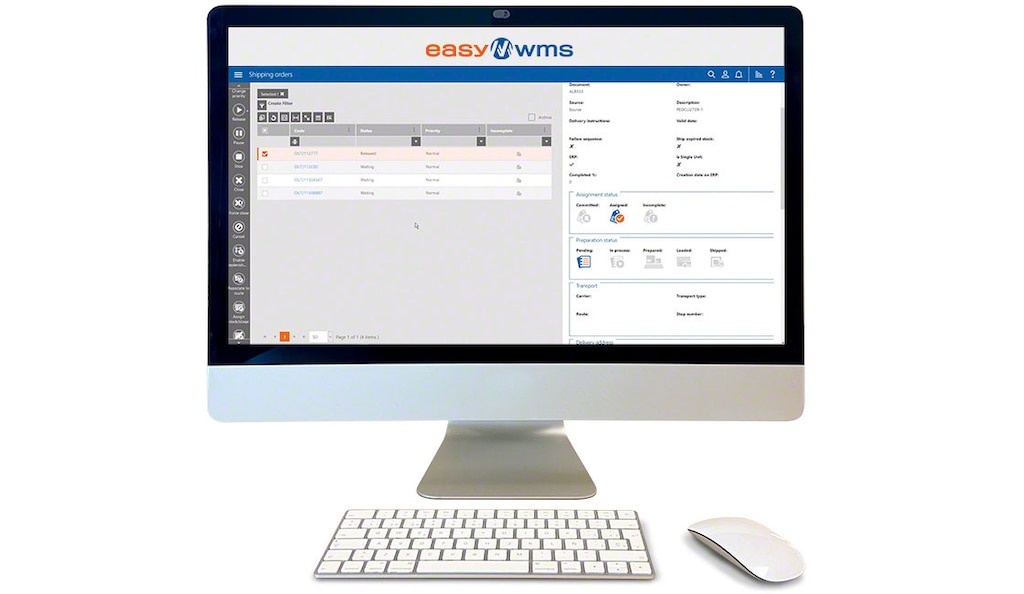
Cloud-based warehouse management system: accessibility and security
A cloud-based warehouse management system (WMS) involves the use of warehouse management software delivered in a software-as-a-service (SaaS) model.
By paying a monthly fee, the company has quick and easy access to the features of the program. This software securely stores all data entered on external servers managed by the WMS provider.
What’s a cloud-based warehouse management system?
A cloud-based WMS refers to a logistics facility with warehouse management software implemented in a SaaS model. With a 100% web-based interface, it can be accessed from any device via an internet connection. External servers are used to run and store the program data, so the business doesn’t need to store any hardware on its premises. The client pays a monthly license fee without having to assume the cost of installation and maintenance of the infrastructure or its own servers.
This contracting mode is swiftly overtaking the on-premise model, whereby the system is installed on a server hosted by and contained within the company itself. Although the user licenses in this case remain the permanent property of the client, the need for the business to invest in its own servers makes the initial outlay significantly higher. According to a study from consulting firm Grand View Research, companies prefer the SaaS model because the implementation and maintenance costs are lower.
Key features
Having a SaaS WMS brings multiple benefits, namely:
- 100% cloud-based. All information and data generated in the logistics facility are captured and stored in the cloud by means of cloud computing.
- Multiuser. Companies can increase or reduce the number of licenses based on their workload and product demand.
- Multi-device. The software can be accessed from any computer or portable device (tablet or smartphone) with an internet connection.
- In real time. Warehouse inventory is continuously updated, e.g., whenever a product is received and stored and an order is prepared and sent to a customer.
- Scalable. The software features can be adjusted, modified, and expanded according to the company’s needs in order to adapt to business growth and fluctuations.
- Secure. There’s no risk of accidental data loss, since backups are made automatically.
More and more companies are managing their logistics facilities with warehouse management software deployed in the SaaS model, regardless of sector or the type of products with which they work.

Inventory control functions
A cloud-based WMS provides businesses with strict inventory control by precisely monitoring all goods movements.
- Stock data in real time. The software assigns a code to each unit load. Thus, the location of each SKU and the quantities available are known at all times, ensuring total stock control.
- Goods flows. The WMS coordinates both the manual movement of goods and that of the automatic equipment to provide traceability of all products.
- Multi-facility scenario. A cloud-based warehouse management system leads to successful multi-location inventory management by integrating and synchronizing information on the various SKUs in the different stages a product goes through.
- Store and warehouse. The catalog for all points of sale — offline and online — is synced according to the stock available in the facility.
The different functions carried out by a cloud-based WMS help to improve the performance of the entire supply chain.
Picking functions
A cloud-based warehouse management system must ensure the effective execution of one of the most complex tasks: order processing. The WMS designs the picking strategy and guides operators in performing this operation.
- Pick path optimization. The most efficient picking routes are established to cut down on operator travel and streamline work.
- Single-unit orders. The software organizes orders made up of only one SKU. This is very common in facilities that employ cross-docking, i.e., that ship goods directly without previously storing them.
- Multi-unit orders. The system also coordinates the picking of multiple SKUs per order, which is typical in e-commerce logistics.
- Integration with picking assistance devices. The WMS can be integrated with a number of picking aids, such as pick-to-light and pick by voice.
When it comes to picking, the main benefit of warehouse management software is efficiency. A WMS minimizes errors, cuts costs, and improves customer service as well as operators’ well-being in the workplace.
Goods management functions
Cloud-based warehouse management software facilitates product control in receiving and dispatch operations.
- Goods receipt. When receiving products, the WMS coordinates with the company’s ERP system to ensure error-free operations. It receives the stock entry order (advance shipping notice) and organizes management of the docking area. Additionally, when data on the stock that’s arrived is entered, the WMS can be configured to create labels that the operator then places on the unit load.
- Storage. A cloud-based warehouse management system makes it possible to parameterize a set of rules and criteria to automatically assign a location to each unit load. This can be based on multiple factors, such as stock turnover, production batch, expiration date, and so on. Easy WMS from Interlake Mecalux incorporates the advanced warehouse slotting feature, which periodically recommends the relocation of certain products based on sales estimates and demand forecasts.
- Dispatches. With the SaaS WMS from Interlake Mecalux, shipping orders can be created to simplify order dispatch management. For example, Easy WMS sorts these orders according to their shipping route. It also coordinates the workstations where operators consolidate and pack the orders.
Thanks to the WMS’s goods management functions, the logistics manager knows the location and the status of the stock in real time.

Integrations
The cloud-based WMS is integrated with the other software applications implemented in the company.
- ERP system. WMS and ERP integration can be carried out in several ways: file by file (XML or EDI) or via exchange databases, web services, or a specific connector (as in the case of SAP and SAP WM). Both software programs work in sync. However, they don’t use the same platform, nor are they designed to fulfill the same function.
- Automatic equipment. The WMS also communicates with the warehouse control system (WCS), which manages all the automated elements in the facility in line with the instructions, rules, and location criteria established by the WMS.
- Communication with carriers. The Multi Carrier Shipping module allows for integration of the WMS with the transportation agencies’ management program to coordinate the shipping process through the exchange of information files.
- Synchronization of online catalog with physical stock. Marketplaces & Ecommerce Platforms Integration, an advanced functionality from Easy WMS, lets businesses sync the catalogs for their online store and marketplaces (e.g., Amazon and eBay) with the physical inventory in the warehouse.
The interaction between the WMS and the various programs run across a company’s supply chain is continuous and bidirectional.
Cloud based warehouse management software: the most efficient solution
A cloud-based WMS gives companies considerable competitive advantages: it optimizes costs with its lower initial investment, speeds up the implementation time, and increases flexibility and scalability to adapt to business variations and growth. One of this cloud-based solution’s strong points is that it minimizes the initial investment and shortens the deployment time.
Want to know more about how a cloud-based warehouse management system can help enhance your logistics processes? Don’t hesitate to contact us. One of our expert consultants will advise you on the best solution for your company.
